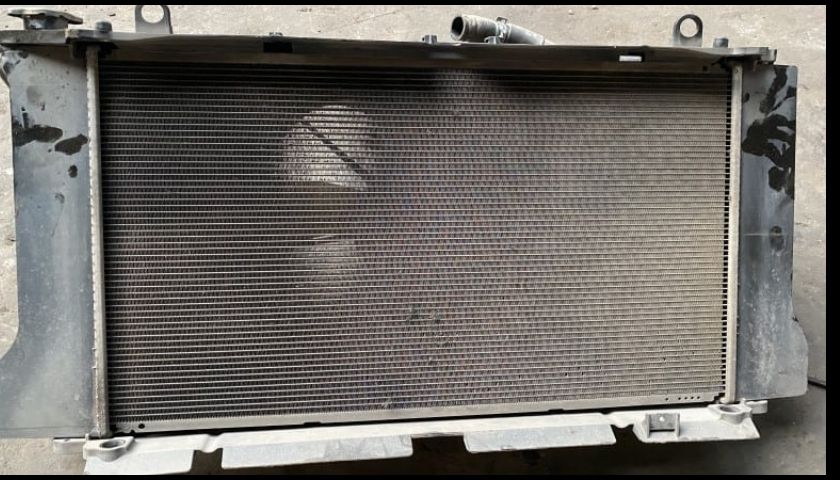How to Clean a Clogged Car Radiator | Symptoms & Solutions

Overheating effect is a very common problem of a car. Do you know why your car become overheated? Though there can be other reasons, a clocked radiator is also responsible for this.
The radiator works for transferring the heat from the fluid inside to the air outside. In this way, the fluid becomes cool, which gradually cools the engine. Usually, radiators are used to intake air, cool automatic transmission fluids, air conditioner refrigerant, and power steering fluid or sometimes to cool motor oil.
Well, do not think that overheating is the only symptom of a blocked radiator. There are various causes to blocked the radiator and multiple signs of this problem also. Let us discuss some of the signs of a blocked radiator here and learn some easy and simple cleaning methods to get rid of this problem.
Contents
Symptoms of the clogged car radiator
When a radiator gets blocked, you could experience some symptoms in your car. These symptoms are:
1. Overheating or high temperature
A clogged car radiator will always lead to an overheated engine. So, if the engine starts overheating, then there may be something wrong with the radiator. You should monitor the temperature gauge to check if the reading is higher than normal. If the gauge shows the reading in the “red” zone, then you should take it seriously. Nowadays, the newer cars display the temperature in a digital miter and warn you whenever the engine temperature gets much higher.
2. Coolant leak
When the radiator gets clogged, the cooling fins can develop small holes or crack on them. If really coolant leaks, you can find some small coolant drops on the ground of the garage or driveway. Use of a low-quality coolant or adding regular tap water can often form rust inside the radiator, which causes cogging.
3. Fluid discoloration
The coolant of the car should be bright yellow or green color. Even sometimes it can be red or pink also. The coolant should flow freely through the coolant passage and radiator inside the engine. You can overflow the coolant tank to check the actual condition. It is the easiest way to check the fluid color.
4. Damaged water pump
A clogged radiator often creates obstacles to coolant from flowing into the water pump. If there is no coolant for lubricating the parts, the metal will start scratching on metal and causing damage to the water pump.
5. Exterior radiator fin blocked
The radiator is designed to ensuring maximum cooling. The radiator comes with thin fin tubes across the front of it to accomplish this work. These tubes contain hot water. If these tubes become clogged with dirt, dry leaves, bugs, or other materials, the air can flow back. Most of the car usually comes with enough access to use a spray nozzle or a garden hose to wash away all debris that can block the radiator’s front.
How to clean a clogged car radiator
If you find one or more symptoms of a clogged radiator, you should run a quick diagnosis to find out the clogging. Let us see how to clean a clogged car radiator.
Allow the engine to become cool before you start cleaning
It can be dangerous if you start cleaning when the engine is still hot. Let it cool down first. When the car engine is in operational condition, the coolant continuously circulates from the engine to the cooling system. The circulation of the cooling system can hamper your cleaning work. So, let it cool down completely.
Put a bucket below the radiator
While you keep the engine at rest to cool down completely, put a small bucket below the radiator. It will hold all the debris that you will flush out.
Remove the radiator cap and fill all tubes with a radiator flush
Once the car becomes cool completely, remove the radiator cap. Take a bottle of radiator flush solution and fill all the tubes with it.
Allow the flush solution to simmer in the radiator for few minutes
Now, wait for about 10 minutes. Allow the flush solution to flow through the piping system and work on cleaning them thoroughly.
Flush out the solution with water
It is a final, easy, and almost effortless process. Take a garden hose and connect it with a water source to rinse the radiator’s interior pipes. Now observe the bucket that you have already put under the car. This bucket may be filled up with debris and other particles that were causing the clog.
Wrapping up
We hope our cleaning guide will help you to clean your clogged car radiator, and now you can do it yourself. It is not much difficult at all. You just need to diagnosis the symptoms to be sure about the clogging. Then follow the cleaning process step by step and remove a clog from the radiator. If you are not confident enough about doing this job, then you can also hire a professional car cleaning team. They will do it for you at a reasonable cost.
Frequently Asked Questions (FAQ)
How do I check if my radiator is clogged?
Check the fluid color of the car. If it resembles brown soup, this is an indication of a clogged radiator. Turn off the car and try to listen to any sound. If it sounds like boiling, this also indicates a blockage.
Will a radiator flush fix a clogged radiator?
Yes, the radiator flush can effectively remove the clog.
Will vinegar clean a car radiator?
As vinegar contain some acidic component, it works well in removing the clog of the radiator.
How do you clean a clogged radiator fin?
Soak the radiator fins into the soap and water for few minutes. Now use a garden hose and rinse them well. The high pressure of the water will make your cleaning work easier.
Will baking soda clean a radiator?
Yes, baking soda is a strong cleaning agent. You can also use it for cleaning the clogged car radiator.








